Ten-year Treasury yields are not going along with the Fed’s tightening posture. This could be because of a technical reason or yields could be sending an ominous message.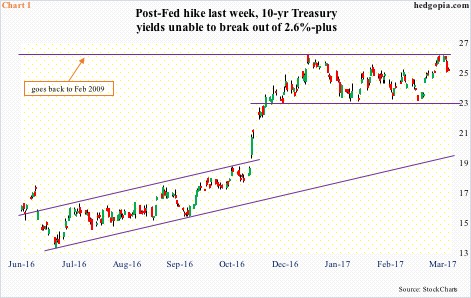
Yields reached a historic low 1.34 percent last July, and have been trending higher since (Chart 1). But they are still caught in a three-decade-old downtrend, which gets broken around three percent. For that to occur, it first needs to take out 2.6 percent, where resistance goes back to February 2009. This was tested on December 15 last year (a day after the Fed raised the fed funds rate to a target range of 0.5 percent to 0.75 percent), and again Monday last week (two days before the most recent hike). Yields are 11 basis points lower from that test.
Leading up to December 2015 (FOMC met on 15-16) when the Fed raised for the first time since June 2006, the spread between two- and 10-year yields was 147 basis points on November 9. Leading up to the hike last December, on the 12th, the spread narrowed to 134 basis points, which narrowed further to 117 bps last Friday (Chart 5).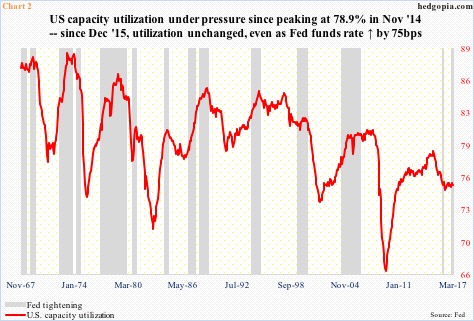
This makes the Fed’s job harder. They would much appreciate if the yield curve steepened.
After remaining easy for years – arguably for way too long – the Fed’s message in recent weeks has been that of a tightening bias. Rhetoric has changed, macro data not much.
Take capacity utilization, for example.
Historically, it is rare for the Fed to begin tightening when utilization is in decline (Chart 2). This cycle has been an exception. Utilization peaked at 78.9 percent in November 2014. At the time of the first hike, in December 2015, utilization stood at 75.4 percent, and this is where it ended up last month.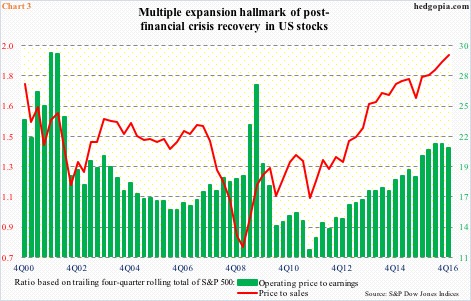
What then is driving the Fed? Their legacy, maybe?
Janet Yellen’s term as Fed chair expires February 3 next year, vice-chairman Stanley Fischer’s ends June 12 next year. As members of the seven-member Board of Governors, these two can stay until January 2024 and January 2020, respectively, but it is conceivable they will retire next year.
Since the Financial crisis, there have been three iterations of quantitative easing (QE), and the fed funds rate was left between zero and 0.25 percent for seven years. This monetary morphine has done wonders to stocks, with persistent multiple expansion. Chart 3 shows how elevated trailing price-to-sales and operating earnings ratios are on the S&P 500 large cap index.
Thus far, stocks have pretty much paid no mind to the three hikes since December 2015. So if Janet Yellen and team have decided to tackle this asset inflation, it will come at a cost. Through wealth effect, consumer spending likely takes a hit.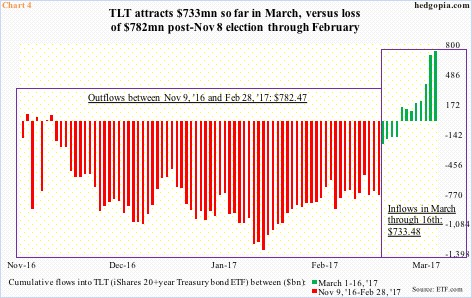
Hence demand for Treasurys, and the resultant downward pressure on yields, even as the short end of the yield curve has shifted up.
So far this month (through last Thursday), TLT, the iShares 20+year Treasury bond ETF, attracted $733 million. This compares with outflows of $782 million from November 9 last year (post-election) through February 28 (Chart 4). There has been a shift in sentiment.
Incidentally, several FOMC members began jawboning the market early this month, including one in which Bill Dudley, New York Fed president, said “animal spirits have been unleashed a bit” post-election. (Prior to this jawboning, I did not think a hike was coming, hence lost a coffee bet with David Hay of Evergreen Gavekal who was adamant they would raise. He writes a fabulous weekly letter. Worth subscribing!)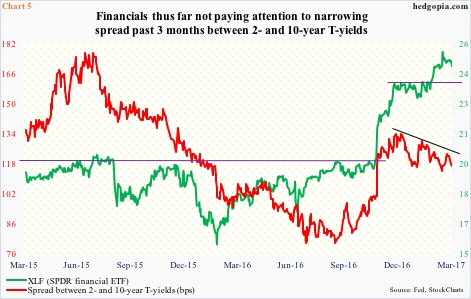
Since November 9 through March 1 record highs, the S&P 500 large cap index rallied 12.2 percent, Dow Industrials 15.5 percent, Nasdaq composite 13.8 percent, and the Russell 2000 small cap index 18.4 percent. Among sectors, financials stand out. Post-election through March 2, XLF, the SPDR financial ETF, rallied 27.1 percent (Chart 5). That high ($25.21) was within a dime of testing the prior high during May 2007. A rejection here can be significant.
Financials rallied primarily in hopes of a steep yield curve. They borrow short, lend long. The current framework in which the Fed is tightening but the long end is declining is spread negative.
Amidst all this, it is possible some of the recent pressure on 10-year yields is technical in nature.
Until two weeks ago, non-commercials held the most net shorts in 10-year note futures (Chart 6). This was a lot of money betting interest rates would continue to head higher. More often than not, when the crowd heavily leans one way, the opposite tends to happen. These traders are now cutting back – cut in half from two weeks ago. Squeezed!
If this is what is causing 10-year yields to go down, the first area for bond bears to put their foot down is 2.31 percent (Chart 1). Then, they need to be able to take out 2.62 percent (Bill Gross’s line in the sand), toward three percent (Jeff Gundlach’s).
Continued failure at 2.62 percent probably does not bode well for financials. The green line in Chart 5 cannot continue diverging with the red.
Thanks for reading!

